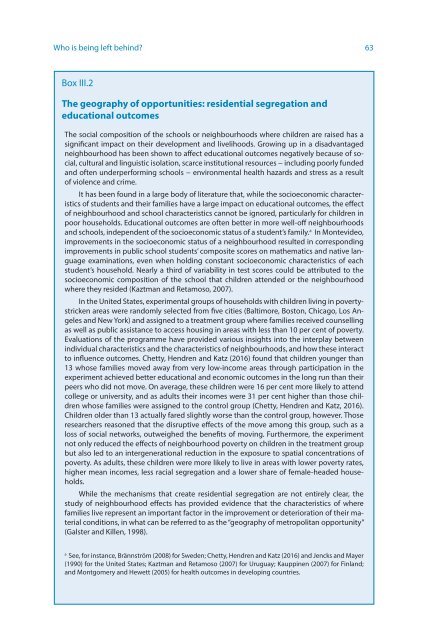Leaving no one behind the imperative of inclusive development
full-report
full-report
Create successful ePaper yourself
Turn your PDF publications into a flip-book with our unique Google optimized e-Paper software.
Who is being left <strong>behind</strong>? 63<br />
Box III.2<br />
The geography <strong>of</strong> opportunities: residential segregation and<br />
educational outcomes<br />
The social composition <strong>of</strong> <strong>the</strong> schools or neighbourhoods where children are raised has a<br />
significant impact on <strong>the</strong>ir <strong>development</strong> and livelihoods. Growing up in a disadvantaged<br />
neighbourhood has been shown to affect educational outcomes negatively because <strong>of</strong> social,<br />
cultural and linguistic isolation, scarce institutional resources − including poorly funded<br />
and <strong>of</strong>ten underperforming schools − environmental health hazards and stress as a result<br />
<strong>of</strong> violence and crime.<br />
It has been found in a large body <strong>of</strong> literature that, while <strong>the</strong> socioeco<strong>no</strong>mic characteristics<br />
<strong>of</strong> students and <strong>the</strong>ir families have a large impact on educational outcomes, <strong>the</strong> effect<br />
<strong>of</strong> neighbourhood and school characteristics can<strong>no</strong>t be ig<strong>no</strong>red, particularly for children in<br />
poor households. Educational outcomes are <strong>of</strong>ten better in more well-<strong>of</strong>f neighbourhoods<br />
and schools, independent <strong>of</strong> <strong>the</strong> socioeco<strong>no</strong>mic status <strong>of</strong> a student’s family. a In Montevideo,<br />
improvements in <strong>the</strong> socioeco<strong>no</strong>mic status <strong>of</strong> a neighbourhood resulted in corresponding<br />
improvements in public school students’ composite scores on ma<strong>the</strong>matics and native language<br />
examinations, even when holding constant socioeco<strong>no</strong>mic characteristics <strong>of</strong> each<br />
student’s household. Nearly a third <strong>of</strong> variability in test scores could be attributed to <strong>the</strong><br />
socioeco<strong>no</strong>mic composition <strong>of</strong> <strong>the</strong> school that children attended or <strong>the</strong> neighbourhood<br />
where <strong>the</strong>y resided (Kaztman and Retamoso, 2007).<br />
In <strong>the</strong> United States, experimental groups <strong>of</strong> households with children living in povertystricken<br />
areas were randomly selected from five cities (Baltimore, Boston, Chicago, Los Angeles<br />
and New York) and assigned to a treatment group where families received counselling<br />
as well as public assistance to access housing in areas with less than 10 per cent <strong>of</strong> poverty.<br />
Evaluations <strong>of</strong> <strong>the</strong> programme have provided various insights into <strong>the</strong> interplay between<br />
individual characteristics and <strong>the</strong> characteristics <strong>of</strong> neighbourhoods, and how <strong>the</strong>se interact<br />
to influence outcomes. Chetty, Hendren and Katz (2016) found that children younger than<br />
13 whose families moved away from very low-income areas through participation in <strong>the</strong><br />
experiment achieved better educational and eco<strong>no</strong>mic outcomes in <strong>the</strong> long run than <strong>the</strong>ir<br />
peers who did <strong>no</strong>t move. On average, <strong>the</strong>se children were 16 per cent more likely to attend<br />
college or university, and as adults <strong>the</strong>ir incomes were 31 per cent higher than those children<br />
whose families were assigned to <strong>the</strong> control group (Chetty, Hendren and Katz, 2016).<br />
Children older than 13 actually fared slightly worse than <strong>the</strong> control group, however. Those<br />
researchers reas<strong>one</strong>d that <strong>the</strong> disruptive effects <strong>of</strong> <strong>the</strong> move among this group, such as a<br />
loss <strong>of</strong> social networks, outweighed <strong>the</strong> benefits <strong>of</strong> moving. Fur<strong>the</strong>rmore, <strong>the</strong> experiment<br />
<strong>no</strong>t only reduced <strong>the</strong> effects <strong>of</strong> neighbourhood poverty on children in <strong>the</strong> treatment group<br />
but also led to an intergenerational reduction in <strong>the</strong> exposure to spatial concentrations <strong>of</strong><br />
poverty. As adults, <strong>the</strong>se children were more likely to live in areas with lower poverty rates,<br />
higher mean incomes, less racial segregation and a lower share <strong>of</strong> female-headed households.<br />
While <strong>the</strong> mechanisms that create residential segregation are <strong>no</strong>t entirely clear, <strong>the</strong><br />
study <strong>of</strong> neighbourhood effects has provided evidence that <strong>the</strong> characteristics <strong>of</strong> where<br />
families live represent an important factor in <strong>the</strong> improvement or deterioration <strong>of</strong> <strong>the</strong>ir material<br />
conditions, in what can be referred to as <strong>the</strong> “geography <strong>of</strong> metropolitan opportunity”<br />
(Galster and Killen, 1998).<br />
a<br />
See, for instance, Brännström (2008) for Sweden; Chetty, Hendren and Katz (2016) and Jencks and Mayer<br />
(1990) for <strong>the</strong> United States; Kaztman and Retamoso (2007) for Uruguay; Kauppinen (2007) for Finland;<br />
and Montgomery and Hewett (2005) for health outcomes in developing countries.
















